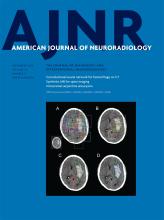Research ArticleAdult Brain
Vessel Wall Enhancement in Unruptured Intracranial Aneurysms: An Indicator for Higher Risk of Rupture? High-Resolution MR Imaging and Correlated Histologic Findings
N. Larsen, C. von der Brelie, D. Trick, C.H. Riedel, T. Lindner, J. Madjidyar, O. Jansen, M. Synowitz and C. Flüh
American Journal of Neuroradiology September 2018, 39 (9) 1617-1621; DOI: https://doi.org/10.3174/ajnr.A5731
N. Larsen
aFrom the Department of Radiology and Neuroradiology (N.L., C.H.R., T.L., J.M., O.J.)
C. von der Brelie
bDepartment of Neurosurgery (C.v.d.B., M.S., C.F.)
dDepartment of Neurosurgery (C.v.d.B.), University Hospital Göttingen, Göttingen, Germany.
D. Trick
cInstitute of Pathology (D.T.), University Hospital Schleswig-Holstein Campus Kiel, Kiel, Germany
C.H. Riedel
aFrom the Department of Radiology and Neuroradiology (N.L., C.H.R., T.L., J.M., O.J.)
T. Lindner
aFrom the Department of Radiology and Neuroradiology (N.L., C.H.R., T.L., J.M., O.J.)
J. Madjidyar
aFrom the Department of Radiology and Neuroradiology (N.L., C.H.R., T.L., J.M., O.J.)
O. Jansen
aFrom the Department of Radiology and Neuroradiology (N.L., C.H.R., T.L., J.M., O.J.)
M. Synowitz
bDepartment of Neurosurgery (C.v.d.B., M.S., C.F.)
C. Flüh
bDepartment of Neurosurgery (C.v.d.B., M.S., C.F.)

References
- 1.↵
- Wiebers DO,
- Whisnant JP,
- Huston J 3rd., et al
- 2.↵
- Vlak MH,
- Algra A,
- Brandenburg R, et al
- 3.↵
- Nieuwkamp DJ,
- Setz LE,
- Algra A, et al
- 4.↵
- Edjlali M,
- Gentric JC,
- Régent-Rodriguez C, et al
- 5.↵
- 6.↵
- Nagahata S,
- Nagahata M,
- Obara M, et al
- 7.↵
- 8.↵
- 9.↵
- 10.↵
- Gounis MJ,
- Vedantham S,
- Weaver JP, et al
- 11.↵
- Gounis MJ,
- van der Marel K,
- Marosfoi M, et al
- 12.↵
- 13.↵
- Maiellaro K,
- Taylor WR
- 14.↵
- Nakatomi H,
- Segawa H,
- Kurata A, et al
- 15.↵
- 16.↵
- 17.↵
- 18.↵
- Dhar S,
- Tremmel M,
- Mocco J, et al
- 19.↵
- Rahman M,
- Smietana J,
- Hauck E, et al
- 20.↵
- 21.↵
- Cebral JR,
- Mut F,
- Weir J, et al
- 22.↵
- Chien A,
- Sayre J,
- Viñuela F
- 23.↵
- Baharoglu MI,
- Lauric A,
- Gao BL, et al
- 24.↵
- Lin N,
- Ho A,
- Gross BA, et al
- 25.↵
- 26.↵
- 27.↵
- 28.↵
- Zheng Y,
- Xu F,
- Ren J, et al
- 29.↵
- Cebral J,
- Ollikainen E,
- Chung BJ, et al
In this issue
American Journal of Neuroradiology
Vol. 39, Issue 9
1 Sep 2018
Advertisement
N. Larsen, C. von der Brelie, D. Trick, C.H. Riedel, T. Lindner, J. Madjidyar, O. Jansen, M. Synowitz, C. Flüh
Vessel Wall Enhancement in Unruptured Intracranial Aneurysms: An Indicator for Higher Risk of Rupture? High-Resolution MR Imaging and Correlated Histologic Findings
American Journal of Neuroradiology Sep 2018, 39 (9) 1617-1621; DOI: 10.3174/ajnr.A5731
0 Responses
Vessel Wall Enhancement in Unruptured Intracranial Aneurysms: An Indicator for Higher Risk of Rupture? High-Resolution MR Imaging and Correlated Histologic Findings
N. Larsen, C. von der Brelie, D. Trick, C.H. Riedel, T. Lindner, J. Madjidyar, O. Jansen, M. Synowitz, C. Flüh
American Journal of Neuroradiology Sep 2018, 39 (9) 1617-1621; DOI: 10.3174/ajnr.A5731
Jump to section
Related Articles
- No related articles found.
Cited By...
- A Review of Intracranial Aneurysm Imaging Modalities, from CT to State-of-the-Art MR
- 3D aneurysm wall enhancement is associated with symptomatic presentation
- Clinical and genetic risk factors and long-term outcomes of MRI vessel wall enhancement in moyamoya disease
- Vessel wall imaging with advanced flow suppression in the characterization of intracranial aneurysms following flow diversion with Pipeline embolization device
- Quantitative analysis of unruptured intracranial aneurysm wall thickness and enhancement using 7T high resolution, black blood magnetic resonance imaging
- Associations between haemodynamics and wall enhancement of intracranial aneurysm
- Regional Aneurysm Wall Enhancement is Affected by Local Hemodynamics: A 7T MRI Study
- Vessel wall imaging in intracranial aneurysms
- Complementary Roles of Dynamic Contrast-Enhanced MR Imaging and Postcontrast Vessel Wall Imaging in Detecting High-Risk Intracranial Aneurysms
- Reply:
- Vessel Wall Enhancement in Treated Unruptured Aneurysms
This article has not yet been cited by articles in journals that are participating in Crossref Cited-by Linking.
More in this TOC Section
Similar Articles
Advertisement











